


xxxxxAn American
by birth, the artist James Whistler spent most of his life in
Europe. He began his career in Paris in 1855 and, initially, under
the influence of his friend Gustav Courbet, produced realist
works, including At the Piano. In the
early 1860s, however, working in London, he became a leading
figure in the Aesthetic Movement, believing in its doctrine of
“art for art’s sake”. A painting, he argued, was not important for
its subject matter, but for the beauty implicit in the composition
and the harmony of colours by which it was portrayed. Thus the
famous painting of his mother, produced in 1871, lacking in depth and muted in tone, was to be
appreciated as An arrangement in Grey and Black.
Many of his works in this original style were influenced by
Japanese art -
JAMES ABBOTT McNEILL WHISTLER
1834 -
Acknowledgements
Whistler:
Portrait by the English artist Walter Greaves (1846-
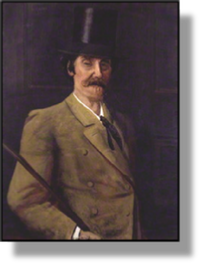
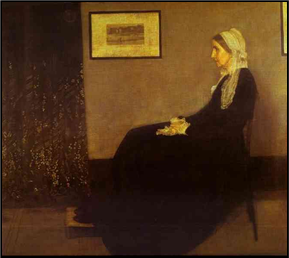 xxxxxJames Abbott McNeill
Whistler was a cosmopolitan American painter and etcher who, by
his technical innovations, became a leading figure in the
Aesthetic Movement and an early champion of modern art. Admired by
some, loathed by others, his daring, original style of painting,
and his flamboyant, egocentric personality made him one of the
most outstanding characters in the artistic world during the
second half of the 19th century. Today, he is remembered above all
for the portrait he painted of his mother -
xxxxxJames Abbott McNeill
Whistler was a cosmopolitan American painter and etcher who, by
his technical innovations, became a leading figure in the
Aesthetic Movement and an early champion of modern art. Admired by
some, loathed by others, his daring, original style of painting,
and his flamboyant, egocentric personality made him one of the
most outstanding characters in the artistic world during the
second half of the 19th century. Today, he is remembered above all
for the portrait he painted of his mother -
xxxxxHe was born
in Lowell, Massachusetts, but he spent most of his life in Europe,
particularly in Paris and London. From the age of nine he spent
six years in St. Petersburg, Russia, where his father, a civil
engineer, was involved in the building of a railroad to Moscow. He
attended the city’s Imperial Academy of Fine Arts, but in 1849 the
family returned to the United States, and two years later he
attended West Point Military Academy. He stayed the course for
three years, but he was not really cut out for a military career,
and was discharged in 1954, ostensibly because he failed a
chemistry examination. He was employed as a draftsman in
Washington for a short while, and it was here that his interest in
etching -
xxxxxHe arrived
in Paris in 1855, and was soon at home as a Bohemian dandy and
wit. As a student he was inspired by the work of the Dutch and
Spanish masters of the 17th century, particularly Rembrandt and
Velasquez, but it was as an etcher that he first made his name and
gained commercial success. His Twelve Etchings
from Nature (the so-
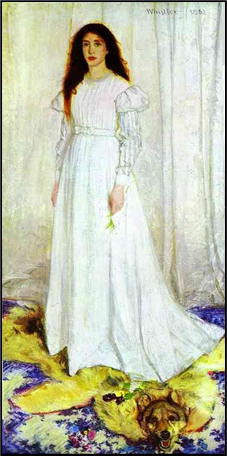 xxxxxButxin 1862, now working in
London, his art took a completely new and largely un-
xxxxxButxin 1862, now working in
London, his art took a completely new and largely un-
xxxxxThis shift
in style was to be seen in a number of transitional works (such as
the Japanese inspired Variations in Flesh
Colour and Green: The Balcony), and
became fully developed in a series of river scenes and stylistic,
full-
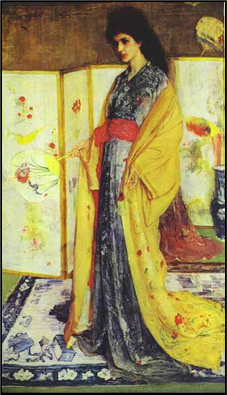 xxxxxThese paintings established Whistler as a
controversial artist of great originality. In some instances they
were clearly influenced by Japanese prints and Asian porcelain, as
seen in works like Purple and Rose: The Lange
Lijzen of the Six Marks, and Rose and
Silver : The Princess from the Land
of Porcelain (illustrated). Oriental art was much in fashion at this time, made
popular by the Paris World Fair of 1867. But Whistler was not
associated with any particular school of painters. He numbered among
his friends Dante Gabriel Rossetti, John Everett Millais and Edward
Burne-
xxxxxThese paintings established Whistler as a
controversial artist of great originality. In some instances they
were clearly influenced by Japanese prints and Asian porcelain, as
seen in works like Purple and Rose: The Lange
Lijzen of the Six Marks, and Rose and
Silver : The Princess from the Land
of Porcelain (illustrated). Oriental art was much in fashion at this time, made
popular by the Paris World Fair of 1867. But Whistler was not
associated with any particular school of painters. He numbered among
his friends Dante Gabriel Rossetti, John Everett Millais and Edward
Burne-
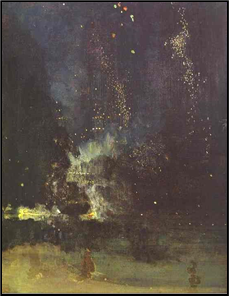 xxxxxIt was one of these Nocturnes,
The Falling Rocket of July 1877 (illustrated) which spelled
disaster for Whistler. The art critic John Ruskin who, along with
William Morris and others, was strongly critical of aestheticism as
applied to art, condemned this painting as unfinished, a “pot of
paint flung in the public’s face”. Whistler sued him for libel and,
revelling in the public attention it created, used the court hearing
to give a theatrical justification of his theories on art.
Technically, he won the case, but he was only awarded one farthing
in damages (one quarter of an old penny!). As a result, the cost of
the trail pushed him deep into debt. This only added to his
troubles. Only the previous year he had lost the support of his
wealthy patron, the Liverpool ship-
xxxxxIt was one of these Nocturnes,
The Falling Rocket of July 1877 (illustrated) which spelled
disaster for Whistler. The art critic John Ruskin who, along with
William Morris and others, was strongly critical of aestheticism as
applied to art, condemned this painting as unfinished, a “pot of
paint flung in the public’s face”. Whistler sued him for libel and,
revelling in the public attention it created, used the court hearing
to give a theatrical justification of his theories on art.
Technically, he won the case, but he was only awarded one farthing
in damages (one quarter of an old penny!). As a result, the cost of
the trail pushed him deep into debt. This only added to his
troubles. Only the previous year he had lost the support of his
wealthy patron, the Liverpool ship-
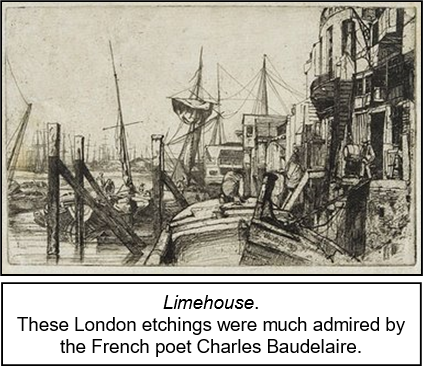
xxxxxDespite efforts to avoid the inevitable, Whistler was declared bankrupt in 1879, and took himself off to Venice with his mistress, Maud Franklin There, over a period of fourteen months, he produced 50 meticulously drawn etchings and over 90 pastels of local scenes. On his return to London, these works, together with the publication of sets of etchings produced earlier in London, France and Amsterdam, helped to provide an income, and went some way to restoring his reputation. By the early 1880s he had regained his position as one of the most colourful characters in London society, and, influenced by the 19th century painter Camille Corot, had turned to the painting of small seascapes in oil and water colour.
xxxxxIn 1888
Whistler married Beatrice, widow of his architect friend William
Godwin, and for a number of years they lived in Paris. Honours
then came his way, and a successful exhibition of his work was
held in 1892. By then Glasgow Corporation had paid 1,000 guineas
for his portrait of the Scottish historian Thomas
Carlyle, and the French government had bought Whistler’s
Mother for the nation -
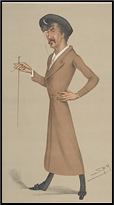 xxxxxA flamboyant dandy who was known for his ready wit
and sharp tongue, Whistler’s literary friends included the poet
Algernon Charles Swinburne -
xxxxxA flamboyant dandy who was known for his ready wit
and sharp tongue, Whistler’s literary friends included the poet
Algernon Charles Swinburne -
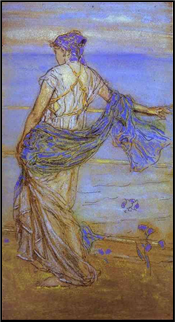
xxxxxIn a long and eventful career, Whistler aroused a great deal of public interest on account of his eccentricity and his artistic arrogance. Wilde once commented that Whistler always spelt art with a capital “I”. His outrageous, unconventional behaviour apart, however, he showed extreme technical proficiency as an artist, and his defence of aesthetic values, based on simple form and harmonious, muted colours, made him a pioneer in the development of abstract art. He also excelled in lithographs, pastels and watercolours, and his etchings place him among the world’s greatest artists in this medium. The pastel shown here is entitled Annabel Lee.
xxxxxIncidentally, in 1866 Whistler, the failed West Point cadet, suddenly went off to take part in a war then being fought in Chile. By the time he arrived in Valparaiso the fighting was virtually over. While there, however, he produced some fine seascapes and views of the harbour, including Nocturne in Blue and Gold: Valparaiso. ……
xxxxx…… His close friendship with Courbet, so important to him when he first began painting, came to an end in 1867. While Whistler was away in Chile his attractive mistress Joanna Hiffernan acted as the model for two of Courbet’s highly erotic paintings, The Sleepers and The Origin of the World. This tarnished their relationship and virtually brought it to an end. ……
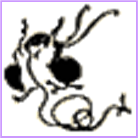
xxxxx…… In 1869 a dispute arose over his signature, and from then he took to signing his paintings with various forms of a stylized butterfly. An early version was thought appropriate by the critics, with the wings symbolising the subtle delicacy of his work and the long tail, complete with sting, representing his sharp tongue and aggressive attitude! ……
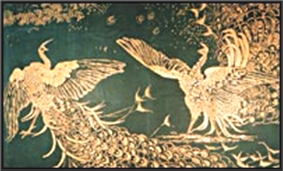
xxxxx…… After the row that erupted in 1876 over the famous “Peacock Room”, Whistler sneaked back to the house and added two fighting peacocks to the décor in the guise of a ruffled Leyland and a hapless Whistler! He called the encounter “Art and Money” or “The Story of the Room”. The room and its décor was taken to the United States in 1904 and eventually put on display in the Freer Gallery of Art in Washington D.C. ……
xxxxx…… The Gilbert and Sullivan comic opera Patience of 1881, a powerful satire on the aesthetic movement, included Whistler as well as Swinburne among those selected for ridicule. The stage character Reginald Bunthorne wore Swinburne’s velvet jacket and sported Whistler’s hair style and monocle. ……
xxxxx…… In 1902 Whistler suffered a heart attack and a Dutch newspaper, misconstruing the news, reported his death. He let the editor know that reading the announcement had brought him “a tender glow of health”.
Vb-

xxxxxShown here
are: Nocturne in blue and silver: The Lagoon,
Venice; The Coast
of Brittany; and Self-
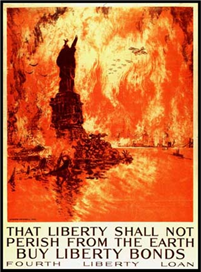 xxxxxThexFrench artist Henri Fantin-
xxxxxThexFrench artist Henri Fantin-


